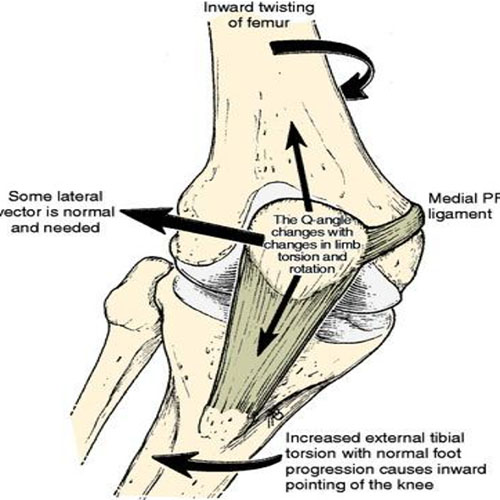Patellofemoral instability

Knee cap plays a major role in knee movements as well as our daily activity. It is the point through which body weight and forces transfer to help in activities like squatting, climbing up & down etc. During this activity the knee cap moves along the center of the knee joint. If knee cap off tracks during knee movement cause instability of knee cap. It is a major concern especially in the young population. Overall incidence is 1 per 1,000,000 with higher incidence at the second decade, which is 30 per 1,000,000 and significantly low after the age of 30. Kneecap instability mostly occurs among young athletic male while performing sports activity as well as in overweight adolescent females.
Kneecap instability ranges from mild tilting to subluxation or complete dislocation at lateral side. Various factors are responsible for keeping it in track within the center of the knee joint while knee movement. These factors are different static and dynamic soft tissue stabilizers around the knee cap, shape of knee cap and thigh bone in relation to knee cap and overall alignment of the lower limb. Deviation of these factors from normal put the knee cap at risk of instability.
Followings are the different conditions which can cause Kneecap instability as a sole factor or in combination.
- Deformed knee cap; patella dysplasia
- Deformed articular surface of thigh bone for knee cap; trochlear dysplasia
- Higher position of knee cap at knee joint; patella alta
- Rotational deformity of thigh bone; excessive femoral anteversion
- Rotational deformity of leg bone; excessive tibial external rotation
- Flat foot; pes planus
- Generalized laxity of joints; hyperlaxity syndrome.
Kneecap instability presents either as acute injury or chronic recurrent dislocation or instability. Acute dislocation is a traumatic event mostly occurs during sports or recreation activity. There is a feeling of POP or SNAP followed by acute pain and swelling of knee joint. Most of the time the knee comes back to its position when the leg gets straight. Sometimes the knee cap may get stuck at the outer aspect of the knee. Physical examination may not be possible due to apprehension from acute pain and swelling due to bleeding inside the knee joint. There may be bruise or ecchymosis on medial aspect of knee joint. Knee cap may get displaced on outer aspect on manipulation. These injuries need to be evaluated for fractures or other ligamentous injury of knee joint. And required immediate active attention to relieve the pain. In acute dislocation medial patellofemoral ligament invariably get injured; mostly complete tear sometimes partial tear. The other injury is osteochondral fracture of patella.
Recurrent dislocation is a more indolent form and usually never present with acute symptoms. Most of the time they give a history of giving way to the knee joint which gets corrected automatically. There may be a previous history of acute dislocation. But in others the presentation is very vague. There may be a sensation of giving way, weakness, difficulty in negotiating stairs and inability to perform sports or recreation activity. Physical examination is done to look for limb alignment, rotational malalignment, tracking of knee cap while knee movement, mediolateral instability of knee cap.
Based on the findings of clinical examination different imaging is required like plain X-ray of knee joint, limb alignment x-ray, MRI of knee joint, CT scan. Different measurements are being evaluated in these imaging to identify the presence and extent of the deformity.
In acute dislocation if there is no osteochondral fracture, underlying bony deformity or limb alignment issue the treatment is conservative for 1st time dislocation. These are Immobilization, icepack, analgesic, aspiration of hemarthrosis. After subsidence of acute swelling and pain physiotherapy rehabilitation is started to restore the mobility and joint function. Most common surgery performed in acute dislocation is fixation of osteochondral fragments and MPFL reconstruction.
In recurrent dislocation different surgical modalities may be required to restore the abnormal anatomy predisposing the condition.
- Reconstruction of medial patellofemoral ligament
- Tibial tubercle (attachment of patellar tendon) shifting osteotomy – medialization or distalization
- Rotational deformity correction osteotomy of thigh bone
- Reconstruction of patellar articulation surface of knee cap; Trochleoplasty
These surgical procedures may require individually or in combination depending on the presence of abnormality detected in different radiological evaluation.
